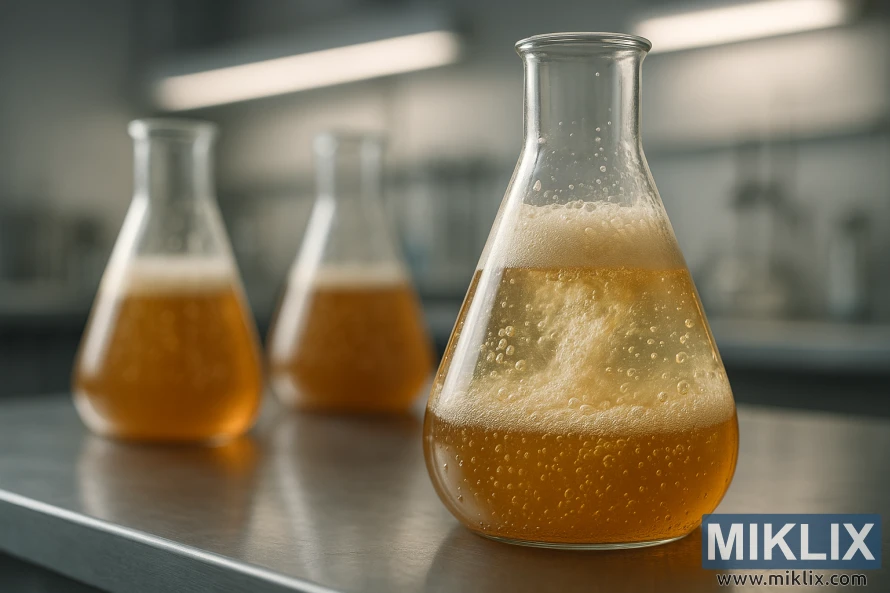Image: Active Fermentation in Flasks
Published: August 12, 2025 at 6:24:12 AM UTC
Last updated: September 27, 2025 at 11:38:33 PM UTC
Three Erlenmeyer flasks with amber liquid fermenting on a stainless steel bench, highlighting yeast activity and lab precision.
On a polished stainless steel bench, beneath the steady glow of diffused laboratory lights, three Erlenmeyer flasks stand as silent witnesses to a living process in motion. Each flask holds an amber-hued liquid, vibrant with activity, alive with countless microscopic transformations that are both unseen and profoundly significant. The foremost vessel, crisp and sharply focused, commands attention. Within its clear glass walls, waves of tiny bubbles surge upward, glimmering as they catch the light, forming trails that speak to the vigor of fermentation. A frothy cap gathers at the top, dense yet delicate, evidence of active yeast working tirelessly to consume sugars and release both carbon dioxide and alcohol. The swirling within is almost hypnotic, a dance of energy and life contained within the conical shape of the flask, a visual representation of brewing’s most crucial transformation.
Behind it, two more flasks recede softly into the blur of background, their contents mirroring the activity of the first, but rendered in gentler focus. They serve to reinforce the sense of scale and repetition inherent in laboratory practice: experiments are never solitary but are performed in multiples, with variations and controls that ensure accuracy and reliability. Their softened outlines lend depth to the composition, emphasizing the clarity and prominence of the closest vessel, drawing the eye to its details while hinting at the larger framework of scientific rigor surrounding it.
The stainless steel bench upon which the flasks rest adds a cool, reflective surface that contrasts with the warm tones of the liquid. Its gleam conveys sterility and cleanliness, qualities indispensable in a controlled brewing environment. Reflections of the vessels shimmer faintly on the bench’s surface, reinforcing the interplay of light, glass, and liquid. Above, the overhead lighting provides a soft, diffused illumination, creating subtle highlights along the curved shoulders of the flasks and glimmers within the effervescent streams of bubbles. Shadows remain minimal, the light serving not to dramatize but to clarify, ensuring every texture of froth, every layer of movement within the liquid is visible with precision.
The background is intentionally muted, a wash of grays and soft forms that hint at shelving, equipment, and the broader expanse of a professional laboratory without distracting from the central focus. This visual restraint underscores the essence of the scene: the relationship between yeast and wort, the moment where living organisms and chemical potential converge to begin the transformation into beer. In these flasks lies the very heart of brewing science, the point where raw ingredients give way to the artistry of fermentation.
The image captures not just a scientific process but also a profound sense of anticipation. To the trained eye, this is the yeast pitching stage, where cells are activated, multiplied, and tested for their vitality. To the casual observer, it may simply appear as liquid in glass, but to the brewer or biologist, it is a glimpse into the essential alchemy that has bound together tradition and science for centuries. These bubbles are not random—they are the breath of yeast, a signal of life at work, a living indicator that the process is healthy and progressing.
There is also artistry in the composition. The triangular geometry of the Erlenmeyer flasks creates balance, while their conical shapes serve both practical and symbolic roles: designed for ease of swirling and gas exchange, yet also emblematic of laboratory precision. Their amber contents glow like captured sunlight, radiating warmth against the otherwise neutral palette, infusing the sterile environment with vitality and color.
What lingers from this image is a sense of dynamic stillness—a frozen moment of ongoing change. The yeast will continue to consume, to multiply, to transform, long after the camera has ceased its gaze. The viewer is left with the impression of being privy to an intimate stage of creation, a rare glimpse into the small-scale processes that, when expanded, result in the rich and complex flavors poured into a glass. In the quiet hum of the laboratory, these flasks embody the confluence of control and chaos, precision and unpredictability, reminding us that brewing is as much about respecting the vitality of yeast as it is about mastering the science of beer.
The image is related to: Fermenting Beer with Fermentis SafAle F-2 Yeast

